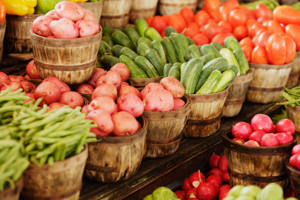Vitamins: Their Functions and Sources
Overview

Vitamins
are divided into two categories.
- Water-soluble vitamins
- These travel freely through the body. The part that the body doesn't use passes through the kidneys and leaves the body as urine or stool. The body needs water-soluble vitamins in frequent, small doses. They aren't likely to reach toxic levels.
- Fat-soluble vitamins
- These are stored in the body's cells. They are not passed out of the body as easily as water-soluble vitamins. Fat-soluble vitamins can reach toxic levels if you get more than you need.
A balanced diet usually provides enough water-soluble and fat-soluble vitamins. People older than 50 and some vegetarians may need to use supplements to get enough B12.
Vitamins
Water-soluble vitamins
|
Vitamin
|
What it does
|
Where it's found
|
|
Thiamine (vitamin B1)
|
Part of an enzyme needed for energy metabolism; important for nerve function.
|
Found in all nutritious foods in moderate amounts: pork, whole-grain or enriched breads and cereals, legumes, nuts and seeds.
|
|
Riboflavin (vitamin B2)
|
Part of an enzyme needed for energy metabolism; important for normal vision and skin health.
|
Milk and milk products; leafy green vegetables; whole-grain or enriched breads and cereals.
|
|
Niacin (vitamin B3)
|
Part of an enzyme needed for energy metabolism; important for nervous system, digestive system, and skin health.
|
Meat, poultry, fish, whole-grain or enriched breads and cereals, vegetables (especially mushrooms, asparagus, and leafy green vegetables), peanut butter.
|
|
Pantothenic acid
|
Part of an enzyme needed for energy metabolism.
|
Widespread in foods.
|
|
Biotin
|
Part of an enzyme needed for energy metabolism.
|
Widespread in foods; also produced in intestinal tract by bacteria.
|
|
Pyridoxine (vitamin B6)
|
Part of an enzyme needed for protein metabolism; helps make red blood cells.
|
Meat, fish, poultry, vegetables, fruits.
|
|
Folate (folic acid)
|
Part of an enzyme needed for making DNA and new cells, especially red blood cells.
|
Leafy green vegetables and legumes, seeds, orange juice, and liver; now added to most refined grains.
|
|
Cobalamin (vitamin B12)
|
Part of an enzyme needed for making new cells; important for nerve function.
|
Meat, poultry, fish, seafood, eggs, milk and milk products; not found in plant foods.
|
|
Ascorbic acid (vitamin C)
|
Antioxidant
; part of an enzyme needed for protein metabolism; important for immune system health; aids in iron absorption.
|
Found only in fruits and vegetables, especially citrus fruits, vegetables in the cabbage family, cantaloupe, strawberries, peppers, tomatoes, potatoes, lettuce, papayas, mangoes, kiwifruit.
|
Fat-soluble vitamins
|
Vitamin
|
What it does
|
Where it's found
|
|
Vitamin A (and its precursor*, beta-carotene)
[*A precursor is converted to the vitamin by the body.]
|
Needed for vision, healthy skin and mucous membranes, bone and tooth growth, immune system health.
|
Vitamin A from animal sources: Fortified milk, cheese, cream, butter, fortified margarine, eggs, liver.
Beta-carotene (from plant sources): Leafy, dark green vegetables; dark orange fruits (apricots, cantaloupe) and vegetables (carrots, winter squash, sweet potatoes, pumpkin).
|
|
Vitamin D
|
Needed for proper absorption of calcium; stored in bones.
|
Egg yolks, liver, fatty fish, fortified milk, fortified margarine. When exposed to sunlight, the skin can make vitamin D.
|
|
Vitamin E
|
Antioxidant; protects cell walls.
|
Polyunsaturated plant oils (soybean, corn, cottonseed, safflower); leafy green vegetables; wheat germ; whole-grain products; liver; egg yolks; nuts and seeds.
|
|
Vitamin K
|
Needed for proper blood clotting.
|
Leafy green vegetables (kale, collard greens, and spinach); green vegetables (broccoli, brussels sprouts, and asparagus); also produced in the intestinal tract by bacteria.
|
Credits
Current as of: October 7, 2024
Current as of: October 7, 2024